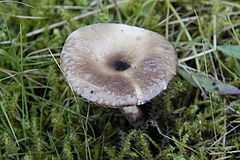Arrhenia
| Arrhenia | |
|---|---|
 | |
| Arrhenia (formerly Omphalina) griseopallida | |
| Scientific classification | |
| Kingdom: | Fungi |
| Division: | Basidiomycota |
| Class: | Agaricomycetes |
| Order: | Agaricales |
| Family: | Hygrophoraceae |
| Genus: | Arrhenia Fr. (1849) |
| Type species | |
| Arrhenia auriscalpium (Fr.) Fr. (1849) | |
| Synonyms[1] | |
Arrhenia is a genus[2][3] of about 25 species in the family Hygrophoraceae.[4] Arrhenia also includes species formerly placed in the genera Leptoglossum and Phaeotellus and the lectotype species itself has an unusual growth form (discussed below) that would not normally be called agaricoid. All of the species grow in association with photosynthetic cryptogams such as mosses, including peat moss, and alga scums on decaying wood, and soil crusts consisting of mixes of such organisms. Typically the fruitbodies of Arrhenia species are grey to black or blackish brown, being pigmented by incrusting melanized pigments on the hyphae.
Etymology
Arrhenia was named for the Swedish botanist Johan Peter Arrhenius.
Species
- A. acerosa
- A. alnetorum
- A. andina
- A. antarctica
- A. auriscalpium
- A. australis
- A. baeospora
- A. chilensis
- A. chlorocyanea
- A. epichysium
- A. elegans
- A. fissa
- A. griseopallida
- A. hohensis
- A. lobata
- A. lundellii
- A. obatra
- A. obscurata
- A. omnivora
- A. onisca
- A. parvivelutina
- A. pauxilla
- A. peltigerina
- A. philonotis
- A. pubescentipes
- A. rainierensis
- A. retiruga
- A. rickenii
- A. rigidipes
- A. rustica
- A. salina
- A. sphaerospora
- A. sphagnicola
- A. spathulata
- A. stercoraria
- A. subandina
- A. subglobispora
- A. subobscura
- A. subumbratilis
- A. trigonospora
- A. umbratillis
- A. velutipes
- A. viridimammata
- A. volkertii
See also
References
- ↑ "Synonymy: Arrhenia Fr., Summa veg. Scand., Section Post. (Stockholm): 312 (1849)". Species Fungorum. CAB International. Retrieved 2014-02-23.
- ↑ Redhead, S.A. et al. (2002a). "Phylogeny of agarics: partial systematics solutions for core omphalinoid genera in the Agaricales (euagarics)". Mycotaxon 83: 19–57.
- ↑ Redhead, S.A. et al. (2002b). "Phylogeny of agarics: partial systematics solutions for bryophilous omphalinoid agarics outside of the Agaricales (euagarics)". Mycotaxon 82: 151–168.
- ↑ Lodge DJ, Padamsee M, Matheny PB, Aime MC, Cantrell SA, Boertmann D et al. (2014). "Molecular phylogeny, morphology, pigment chemistry and ecology in Hygrophoraceae (Agaricales)". Fungal Diversity 64 (1): 1–99. doi:10.1007/s13225-013-0259-0.